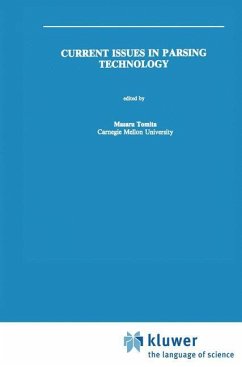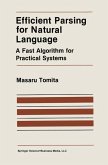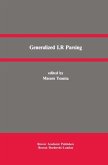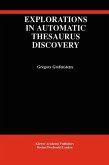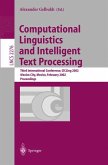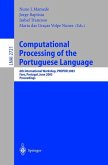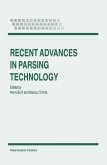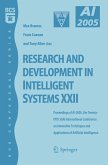Andere Kunden interessierten sich auch für
![Efficient Parsing for Natural Language Efficient Parsing for Natural Language]() M. TomitaEfficient Parsing for Natural Language77,99 €
M. TomitaEfficient Parsing for Natural Language77,99 €![Generalized LR Parsing Generalized LR Parsing]() M. Tomita (Hrsg.)Generalized LR Parsing77,99 €
M. Tomita (Hrsg.)Generalized LR Parsing77,99 €![Explorations in Automatic Thesaurus Discovery Explorations in Automatic Thesaurus Discovery]() Gregory GrefenstetteExplorations in Automatic Thesaurus Discovery115,99 €
Gregory GrefenstetteExplorations in Automatic Thesaurus Discovery115,99 €![Computational Linguistics and Intelligent Text Processing Computational Linguistics and Intelligent Text Processing]() Alexander Gelbukh (ed.)Computational Linguistics and Intelligent Text Processing39,99 €
Alexander Gelbukh (ed.)Computational Linguistics and Intelligent Text Processing39,99 €![Computational Processing of the Portuguese Language Computational Processing of the Portuguese Language]() Nuno J. Mamede / Jorge Baptista / Isabel Trancoso / Maria das Gracas Volpe Nunes (eds.)Computational Processing of the Portuguese Language39,99 €
Nuno J. Mamede / Jorge Baptista / Isabel Trancoso / Maria das Gracas Volpe Nunes (eds.)Computational Processing of the Portuguese Language39,99 €![Recent Advances in Parsing Technology Recent Advances in Parsing Technology]() H. Bunt / M. Tomita (Hgg.)Recent Advances in Parsing Technology77,99 €
H. Bunt / M. Tomita (Hgg.)Recent Advances in Parsing Technology77,99 €![Research and Development in Intelligent Systems XXII Research and Development in Intelligent Systems XXII]() Max Bramer / Frans Coenen / Tony Allen (eds.)Research and Development in Intelligent Systems XXII153,99 €
Max Bramer / Frans Coenen / Tony Allen (eds.)Research and Development in Intelligent Systems XXII153,99 €-
-
-
Produktdetails
- The Springer International Series in Engineering and Computer Science 126
- Verlag: Springer / Springer US / Springer, Berlin
- Artikelnr. des Verlages: 978-0-7923-9131-9
- 1991.
- Seitenzahl: 324
- Erscheinungstermin: 31. Dezember 1990
- Englisch
- Abmessung: 241mm x 160mm x 23mm
- Gewicht: 649g
- ISBN-13: 9780792391319
- ISBN-10: 0792391314
- Artikelnr.: 21714136
Hinweis: Dieser Artikel kann nur an eine deutsche Lieferadresse ausgeliefert werden.
- Herstellerkennzeichnung
- Springer-Verlag GmbH
- Tiergartenstr. 17
- 69121 Heidelberg
- ProductSafety@springernature.com
1 Why Parsing Technologies?.- 1.1 The gap between theory and application.- 1.2 About this book.- 2 The Computational Implementation of Principle-Based Parsers.- 2.1 Introduction.- 2.2 The principle ordering problem.- 2.3 Examples of parsing using the Po-Parser.- 2.4 Concluding remarks.- 3 Parsing with Lexicalized Tree Adjoining Grammar.- 3.1 Introduction.- 3.2 Lexicalization of CFGs.- 3.3 Lexicalized TAGs.- 3.4 Parsing lexicalized TAGs.- 3.5 Concluding remarks.- 4 Parsing with Discontinuous Phrase Structure Grammar.- 4.1 Introduction.- 4.2 Trees with discontinuities.- 4.3 Disco-Trees in grammar rules.- 4.4 Implementing DPSG: An enhanced chart parser.- 4.5 Concluding remarks.- 5 Parsing with Categorial Grammar in Predictive Normal Form.- 5.1 Introduction.- 5.2 Overview of predictive normal form.- 5.3 Source grammar (G).- 5.4 Predictive normal form (G).- 5.5 Ambiguity in G.- 5.6 Equivalence of G and G.- 5.7 Concluding remarks.- 6 PREMO: Parsing by conspicuous lexical consumption.- 6.1 Introduction.- 6.2 The preference machine.- 6.3 Global data.- 6.4 Preference semantics.- 6.5 PREMO example.- 6.6 Comparison to other work.- 6.7 Concluding remarks.- 7 Parsing, Word Associations, and Typical Predicate-Argument Relations.- 7.1 Mutual information.- 7.2 Phrasal verbs.- 7.3 Preprocessing the corpus with a part of speech tagger.- 7.4 Preprocessing with a syntactic parser.- 7.5 Significance levels.- 7.6 Just a powerful tool.- 7.7 Practical applications.- 7.8 Alternatives to collocation for recognition applications.- 7.9 Concluding remarks.- 8 Parsing Spoken Language Using Combinatory Grammars.- 8.1 Introduction.- 8.2 Structure and intonation.- 8.3 Combinatory grammars.- 8.4 Parsing with CCG.- 8.5 Intonational structure.- 8.6 A hypothesis.- 8.7 Conclusion.- 9 A Dependency-Based Parser for Topic and Focus.- 9.1 Introduction.- 9.2 Dependency-based output structures.- 9.3 The semantic impact of topic-focus articulation.- 9.4 Parsing procedure for topic and focus.- 9.5 Parsing sentences in a text.- 9.6 Concluding remarks.- 10 A Probabilistic Parsing Method for Sentence Disambiguation.- 10.1 Introduction.- 10.2 Probabilistic context-free grammar.- 10.3 Experiments.- 10.4 Concluding remarks.- 11 Towards a Uniform Formal Framework for Parsing.- 11.1 Introduction.- 11.2 Context-free parsing.- 11.3 Horn clauses.- 11.4 Other linguistic formalisms.- 11.5 Concluding remarks.- 12 A Method for Disjunctive Constraint Satisfaction.- 12.1 Introduction.- 12.2 Turning disjunctions into contexted constraints.- 12.3 Normalizing the contexted constraints.- 12.4 Extracting the disjunctive residue.- 12.5 Producing the models.- 12.6 Comparison with other techniques.- 12.7 Concluding remarks.- 13 Polynomial Parsing of Extensions of Context-Free Grammars.- 13.1 Introduction.- 13.2 Linear indexed grammars.- 13.3 Combinatory categorial grammars.- 13.4 Tree Adjoining Grammars.- 13.5 Importance of linearity.- 13.6 Concluding remarks.- 14 Overview of Parallel Parsing Strategies.- 14.1 Introduction.- 14.2 From one to many traditional serial parsers.- 14.3 Translating grammar rules into process configurations.- 14.4 From sentence words to processes.- 14.5 Connectionist parsing algorithms.- 14.6 Concluding remarks.- 15 Chart Parsing for Loosely Coupled Parallel Systems.- 15.1 Introduction.- 15.2 Parsing for loosely coupled systems.- 15.3 Parallelism and the chart.- 15.4 Distributing the chart.- 15.5 Communication vs. computation - Results for the Hypercube(TM).- 15.6 Towards wider comparability - The abstract parallel agenda.- 15.7 Termination and Synchronization.- 15.8 Testingthe portable system - Results of network experiment.- 15.9 Alternative patterns of edge distribution.- 15.10 Concluding remarks.- 16 Parsing with Connectionist Networks.- 16.1 Introduction.- 16.2 Incremental parsing.- 16.3 Connectionist network formalism.- 16.4 Parsing network architecture.- 16.5 Parsing network performance.- 16.6 Extensions.- 16.7 Concluding remarks.- 17 A Broad-Coverage Natural Language Analysis System.- 17.1 Introduction.- 17.2 A syntactic sketch: PEG.- 17.3 Semantic readjustment.- 17.4 The paragraph as a discourse unit.- 17.5 Concluding remarks.- 18 Parsing 2-Dimensional Language.- 18.1 Introduction.- 18.2 The 2D-Earley parsing algorithm.- 18.3 The 2D-LR parsing algorithm.- 18.4 More interesting 2D grammars.- 18.5 Formal property of 2D-CFG.- 18.6 Concluding remarks.
1 Why Parsing Technologies?.- 1.1 The gap between theory and application.- 1.2 About this book.- 2 The Computational Implementation of Principle-Based Parsers.- 2.1 Introduction.- 2.2 The principle ordering problem.- 2.3 Examples of parsing using the Po-Parser.- 2.4 Concluding remarks.- 3 Parsing with Lexicalized Tree Adjoining Grammar.- 3.1 Introduction.- 3.2 Lexicalization of CFGs.- 3.3 Lexicalized TAGs.- 3.4 Parsing lexicalized TAGs.- 3.5 Concluding remarks.- 4 Parsing with Discontinuous Phrase Structure Grammar.- 4.1 Introduction.- 4.2 Trees with discontinuities.- 4.3 Disco-Trees in grammar rules.- 4.4 Implementing DPSG: An enhanced chart parser.- 4.5 Concluding remarks.- 5 Parsing with Categorial Grammar in Predictive Normal Form.- 5.1 Introduction.- 5.2 Overview of predictive normal form.- 5.3 Source grammar (G).- 5.4 Predictive normal form (G).- 5.5 Ambiguity in G.- 5.6 Equivalence of G and G.- 5.7 Concluding remarks.- 6 PREMO: Parsing by conspicuous lexical consumption.- 6.1 Introduction.- 6.2 The preference machine.- 6.3 Global data.- 6.4 Preference semantics.- 6.5 PREMO example.- 6.6 Comparison to other work.- 6.7 Concluding remarks.- 7 Parsing, Word Associations, and Typical Predicate-Argument Relations.- 7.1 Mutual information.- 7.2 Phrasal verbs.- 7.3 Preprocessing the corpus with a part of speech tagger.- 7.4 Preprocessing with a syntactic parser.- 7.5 Significance levels.- 7.6 Just a powerful tool.- 7.7 Practical applications.- 7.8 Alternatives to collocation for recognition applications.- 7.9 Concluding remarks.- 8 Parsing Spoken Language Using Combinatory Grammars.- 8.1 Introduction.- 8.2 Structure and intonation.- 8.3 Combinatory grammars.- 8.4 Parsing with CCG.- 8.5 Intonational structure.- 8.6 A hypothesis.- 8.7 Conclusion.- 9 A Dependency-Based Parser for Topic and Focus.- 9.1 Introduction.- 9.2 Dependency-based output structures.- 9.3 The semantic impact of topic-focus articulation.- 9.4 Parsing procedure for topic and focus.- 9.5 Parsing sentences in a text.- 9.6 Concluding remarks.- 10 A Probabilistic Parsing Method for Sentence Disambiguation.- 10.1 Introduction.- 10.2 Probabilistic context-free grammar.- 10.3 Experiments.- 10.4 Concluding remarks.- 11 Towards a Uniform Formal Framework for Parsing.- 11.1 Introduction.- 11.2 Context-free parsing.- 11.3 Horn clauses.- 11.4 Other linguistic formalisms.- 11.5 Concluding remarks.- 12 A Method for Disjunctive Constraint Satisfaction.- 12.1 Introduction.- 12.2 Turning disjunctions into contexted constraints.- 12.3 Normalizing the contexted constraints.- 12.4 Extracting the disjunctive residue.- 12.5 Producing the models.- 12.6 Comparison with other techniques.- 12.7 Concluding remarks.- 13 Polynomial Parsing of Extensions of Context-Free Grammars.- 13.1 Introduction.- 13.2 Linear indexed grammars.- 13.3 Combinatory categorial grammars.- 13.4 Tree Adjoining Grammars.- 13.5 Importance of linearity.- 13.6 Concluding remarks.- 14 Overview of Parallel Parsing Strategies.- 14.1 Introduction.- 14.2 From one to many traditional serial parsers.- 14.3 Translating grammar rules into process configurations.- 14.4 From sentence words to processes.- 14.5 Connectionist parsing algorithms.- 14.6 Concluding remarks.- 15 Chart Parsing for Loosely Coupled Parallel Systems.- 15.1 Introduction.- 15.2 Parsing for loosely coupled systems.- 15.3 Parallelism and the chart.- 15.4 Distributing the chart.- 15.5 Communication vs. computation - Results for the Hypercube(TM).- 15.6 Towards wider comparability - The abstract parallel agenda.- 15.7 Termination and Synchronization.- 15.8 Testingthe portable system - Results of network experiment.- 15.9 Alternative patterns of edge distribution.- 15.10 Concluding remarks.- 16 Parsing with Connectionist Networks.- 16.1 Introduction.- 16.2 Incremental parsing.- 16.3 Connectionist network formalism.- 16.4 Parsing network architecture.- 16.5 Parsing network performance.- 16.6 Extensions.- 16.7 Concluding remarks.- 17 A Broad-Coverage Natural Language Analysis System.- 17.1 Introduction.- 17.2 A syntactic sketch: PEG.- 17.3 Semantic readjustment.- 17.4 The paragraph as a discourse unit.- 17.5 Concluding remarks.- 18 Parsing 2-Dimensional Language.- 18.1 Introduction.- 18.2 The 2D-Earley parsing algorithm.- 18.3 The 2D-LR parsing algorithm.- 18.4 More interesting 2D grammars.- 18.5 Formal property of 2D-CFG.- 18.6 Concluding remarks.

